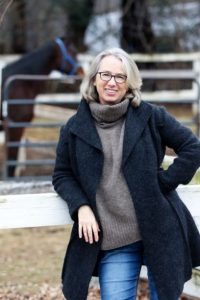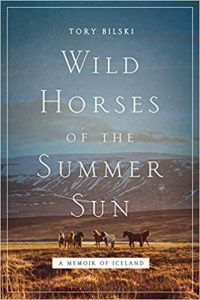Iceland and Horses: How I Came to Write a Memoir
 I didn’t set out to write a memoir. I knew I wanted to write something about a horse farm in the north of Iceland where I traveled every summer with a group of friends. My traveling mates were a lovable, kooky, lively, and voluble group of women worthy of a story. After many years of trips, I had a lot of material to work with — all of our adventures and misadventures — but I didn’t have the narration fixed.
I didn’t set out to write a memoir. I knew I wanted to write something about a horse farm in the north of Iceland where I traveled every summer with a group of friends. My traveling mates were a lovable, kooky, lively, and voluble group of women worthy of a story. After many years of trips, I had a lot of material to work with — all of our adventures and misadventures — but I didn’t have the narration fixed.In the beginning, I was of two minds: to write the story as a novel or to write it as a series of travel essays where I was not the focus, but a silent observant scribe.
Regardless of the narration technique, the set-up would be the same — a group of ordinary yet adventurous women living a week each year in an extraordinary place on the edge of the Arctic circle, a remote oasis of peace in an otherwise noisy chaotic world. Horses, a beautiful setting, 24 hours of sunlight, fast rides —that was what I wanted to capture.
The arc of the story would also be the same whether it was fiction or non-fiction: the early years when we traveled as a group of ten, unfamiliar with the place and each other; the middle years when the group once winnowed down to four and nearly flamed out; the later years that brought with them a renewed commitment to traveling together as long as we possibly could. The ending was amorphous, because we were still going every year.
I had been writing fiction for years, so it was natural to first see the book as a novel with a third person, omniscient narrator. But I didn’t have the courage to start it. To begin writing a new new book of any kind takes a certain amount of delusional hope. Though I had some early success placing a few short stories, and had published articles, I had also written five novels over a span of thirty years and, like most writers, had a collection of very encouraging rejection letters. My husband always buoyed me by saying, “Take heart, you are good at writing, just lousy at getting published.”
So I could not bear to spend years writing another book with the likelihood of it never being published. And while self-publishing had become easier, I could do that with a book I had already written. Not start yet another.
But the stories of Iceland churned in my mind. I felt a book coming on, like one senses the start of a flu — a persistent headache, a flush of fever, then a low grade malaise. What to do with this feeling? I just wanted to get over it.
And then as if on cue, an illness put me out of commission. I couldn’t go to Iceland one summer and bereft at all I was missing, I put up an experiential travel blog. I told the tales that amused me most, using the ‘we’ ‘our’ ‘us’ pronouns, keeping the spotlight on the collective nature of our adventures. I was just the one who wrote them down, the silent hand on the tiller.
I found blogging addictive, particularly the immediacy and international reach. It was a writer’s dream: create a story, post it, and get immediate reader feedback. People followed my blog, liked and commented on it, and asked questions about Iceland. Of course I became obsessed with checking the amount of clicks on each post. There were the highs of a new post, the lows being how quickly the audience faded. I called myself a blogger and reveled in my new identity. But old habits die hard; I wanted to turn it into a book.
If there isn’t already, there should be a German word that expresses a long-wished-for dream that has been crushed by rejection, exhausted from failure, dashed by reality — only to then, just when you are ready to give up and accept your fate, have the wheels of fortune spin in your favor. There ought to be a word for that. It ought to express how one is about to succumb to hopelessness given the odds, only to be proven wrong, and shown that the odds are nothing but that. Odds. And sometimes when not trying to beat the odds, a gift lies in wait for you. I guess there’s an English phrase for this: right time, right place.
In short, an agent heard about the blog and became interested. She offered to take a look if I sent her a book proposal and half the book. For the first time in my life, I wrote quickly. I have a full time job, so I woke early to write and stayed up late at night to re-write. When I thought it was finished, I sent it off to the agent, who basically said, this is all very good, but where are you in it? This has to be your story, it’s a memoir, it needs you.
That became my task then, to integrate myself into the book. To come out publicly on the page. To give my inherent shyness a microphone. To give myself permission and authority to bear witness. What parts of myself do I want to open up about, which of my thoughts and perceptions do I want to share? How carefully do I listen to what is going on around me? What conversations are important? What observations, what sounds and visuals are necessary? My memoir is about carving out a space in our lives, a place on earth where we find joy, and where what lies dormant in our hearts is awoken. The charge was, is, as Mary Oliver writes: “Pay attention. Be astonished. Tell about it. “
—
Tory Bilski is travel writer based in Connecticut. She writes primarily about Iceland – its people, horses, and history. In 2013, she created an award-winning blog, Icelandica. She has recently written for Atlas Obscura, Hartford Courant, Roads & Kingdoms, Iceland Review, and others. In the more distant past, she published short stories in literary journals: Kenyon Review, Black Warrior Review, 13th Moon.
Instagram: @exploratoryish
Twitter: @exploratoryish
FB: www.facebook.com/
www.amazon.com/Wild-Horses-
WILD HORSES OF THE SUMMER SUN
 A wondrous story of adventure and friendship featuring a group of women who ride Icelandic horses.
A wondrous story of adventure and friendship featuring a group of women who ride Icelandic horses.
“Blame it or praise it, there is no denying the wild horse in us.”―Virgina Woolf
Each June, Tory Bilski meets up with fellow women travelers in Reykjavik where they head to northern Iceland, near the Greenland Sea. They escape their ordinary lives to live an extraordinary one at a horse farm perched at the edge of the world. If only for a short while.
When they first came to Thingeryar, these women were strangers to one another. The only thing they had in common was their passion for Icelandic horses. However, over the years, their relationships with each other deepens, growing older together and keeping each other young.
Combining the self-discovery of Eat, Pray, Love, the sense of place of Under the Tuscan Sun, and the danger of Wild, Wild Horses of the Summer Sun revels in Tory’s quest for the “wild” inside her.
Category: Contemporary Women Writers, How To and Tips






























